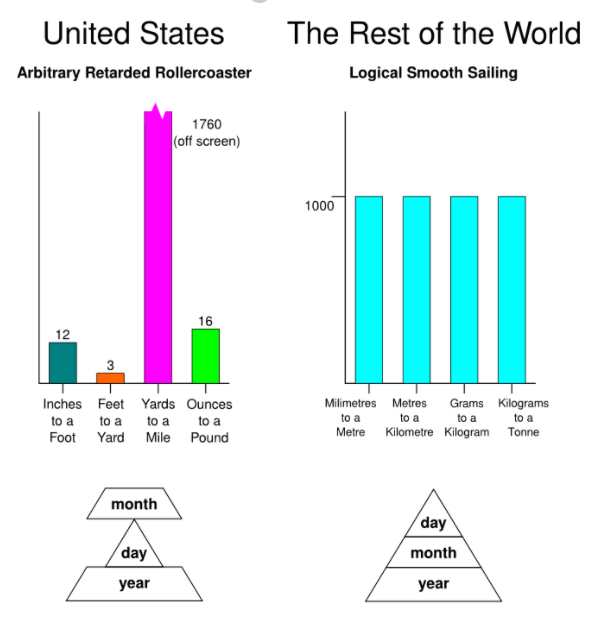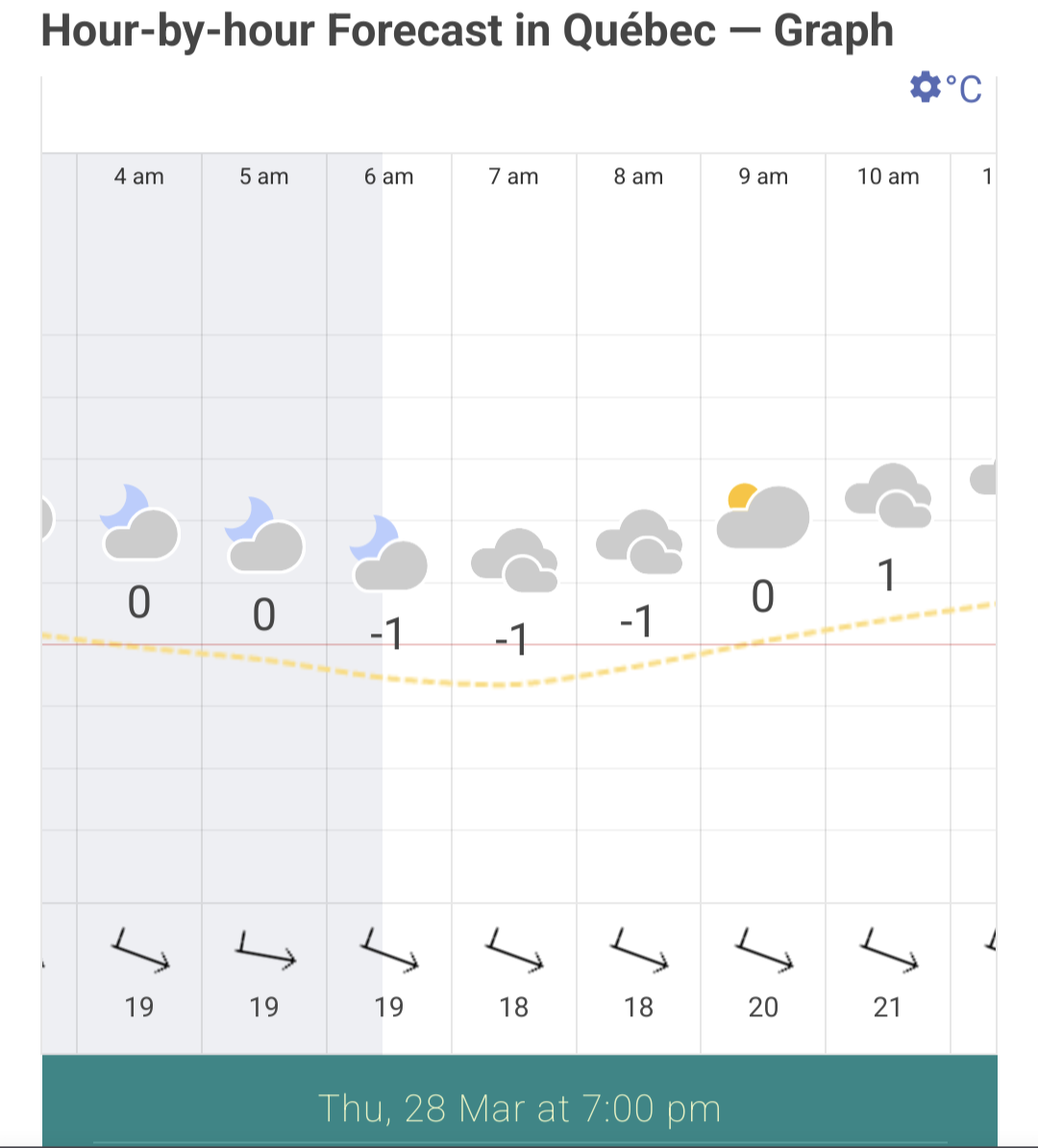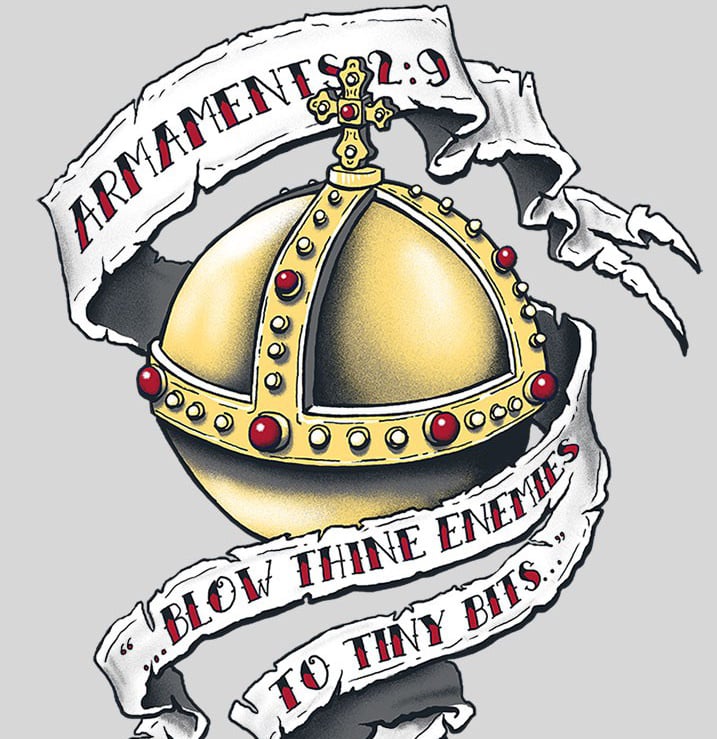I have this theory that Americans suck at math because they insist on sticking with the imperial measurement system and so nothing makes mathematical sense - Americans intuitively just think in every day units qualitatively. Whereas the rest of the world uses metric, so base 10 math just comes naturally.
Source: I am a US STEM professor. Our students suck at math.
When I was 16, I went to high school in California for half a year as an exchange student. I am from Germany and as a junior, I would have had something like my 4th or 5th year of chemistry in school, but out of necessity (or laziness) I took beginner’s chemistry.
For exercises I had been paired with two girls who used to try to make fun of me (I think; I never really figured out what their deal was), and asked me stupid questions about myself or Germany. I remember they once asked laughingly whether I like oranges because I was wearing a t-shirt with an orange print.
Well, then one day, there we go. Converting exercises. You have students from 9th to 12th grade in groups of 3-4, trying to convert imperial measurements to metrics. And then metrics to metrics. Basically, for a couple of weeks, we just converted stuff like 14 cm to mm or dm. I forgot so much about my time abroad but the most vivid memory I have is of the girls looking at each other (after a couple of days and repeated explanations) and one says “the decimal system just makes no sense” and the other one quietly and slowly nods in agreement. I ask them how it makes no sense. “Well it just makes no sense.” It’s just base 10 everything and the rest is practice, it’s not different from inches to feet. “No but you see this makes sense. There are 12 inches in a foot”, continued by a list of how many shmekels make up a whoopsiedoodle and how many dingelings fit into a hybotron.
I understand how you first have to get accustomed to new units and how conversion might need practice when you aren’t familiar with the prefixes, especially when you aren’t too experienced in the stem field. But I am still flabbergasted by the statement that having a system where everything is just base 10 and then you shift the decimal point around makes no sense. We are talking about fellow juniors here. How do you make it to age 16/17 never having heard of a decimal point or having trouble with base 10 conversion? HOW CAN YOU SAY IT MAKES NO SENSE?! It’s the simplest, most logic based system there is!
IMO metric also allows you to reason about things in your head more easily because doing base-10 calculations in your head is doable.
For example, “Each 1m section of a pipeline contains 20L of oil. The goal is to empty a 200 km section of pipe into trucks. If each truck can handle 20 tonnes of oil, how many trucks would be needed?” In metric that calculation is 20 * 1000 * 200 = 4 million L. 20 tonnes is approx 20,000 L since 1L of water is 1kg, so it’s going to be at least within an order of magnitude of that for oil. 4M / 20k = 200.
With US customary units it would be "Each 1 foot section of a pipeline contains 1.5 gallons of oil. The goal is to empty a 100 mile section of pipe into trucks. If each can handle 20 tons of oil, how many trucks will be needed? To handle that calculation you’ll have to convert feet to miles. Gallons to pounds, pounds to tons, etc. You can do it on paper, but all those weird conversions add massively to the difficulty.
There’s a reason why the American science community has long converted to metric. You just can’t do calculations like this quickly enough.
well how dense is the oil
Not as dense as those teenagers
True, also i side note. Tanker turks are measured in Volume here. Thats makes it easier
I’m imagining a tank wearing a fez.
tanker trucks
Crude is approximately the same as water, about 0.8 to 0.9 g/mL. But, even if it were significantly less dense, like gasoline (0.74 g/mL) it’s still good for an order-of-magnitude calculation. Knowing that 1L has a mass of 1kg is especially useful since many of the liquids we commonly encounter are water-based.
.8 to .9 for crude (where water is 1)
Fuck me we did those conversions in primary school in Italy in the eighties. Can’t remember what year exactly but we were prolly 7yo?
Exactly, we also had this early on. Also with imperial measurements or some random antique ones. I remember the worst conversion exercises were in grade 5, where you had to convert a large number, say 5316, to a number if the base was 8, not 10. This felt completely useless and took a lot of time but it also wasn’t necessarily hard. And it made sense because math usually does.
ok how about this america abopts the metric system but every moves on to base 12.
Fifth grade prepared me for base whatever, bring it on
Ok in base pi what is 10
Oh that’s a great question, we only did integers as bases - my guess would be 100.58 (or 100.18)? But I absolutely admit defeat here.
Non-integer base, anyone?
2i is also fun
It may be that or it may be that our entire educational system has turned into shit through decades of low pay for teachers weeding out all the best people.
I am a US STEM professor.
Prove it! What is the speed of light in anacondas/average Snapchat duration?
Edit: around 10^11 anacondas per average daily snapchat usage among US teens
Does the person on Snapchat have buns? 'Cause otherwise my anaconda don’t want none, hun.
Isn’t there a filter for that?
2! No, 3!
deleted by creator
I have a theory that Americans are great at math because they regularly work with base-12 systems.
That would be cool if true. But then they use measures like subdivisions of an inch in base 8 increments.
It’s closer to a binary system, since it’s iterative division by two. Half inch, quarter, eighth, sixteenth and so on.
People do the same thing in metric, but they just prefer to write 0.125 cm instead of 1/8 cm.
Imperial units are a bit more heavy on rational numbers instead of decimal.
The base 12 stuff comes up with things that were historically cut in halves as well as thirds.
It’s all highly composite numbers, since they’re easier to work with if you’re doing repeated division in your head. Ten is only divisible by 2 and 5 before you start to get a lot of rapidly growing decimal parts. 12 is divisible by 2,3,4,6.
If you’ve got a balance, a knife and a stone we all agree on the weight of (let’s call it a pound stone), it’s easy to measure our a half or third of a pound, and halves or thirds of any other portion I can produce.
Over time, common divisions got names and a system of units was produced that was entirely inconsistent but liked 12 and 60 because of ease of use, and powers of two because you can just keep cutting them in half.It’s all moot since we can use a scale now instead of a balance with a rock, and we can trust measuring tapes instead of repeatedly bisecting a plank, but it at least gives context to why it prefers fractions and numbers like 12 and 8.
And base 3 sometimes (yards). When taught well, there’s a ton of value in learning to quantify the world in a variety of base systems.
Not uniquely American, but thinking in base 7 (weeks), base 12 (years, hours, feet), base 60 (minutes), base 3 (yards), base 10 (the default unless told otherwise), etc. really helps you adapt and estimate a number of other, unrelated, things.
My professor for my first real engineering class had an excellent quote, “A good engineer can work in any unit system.”
There’s actually quite a lot of advantages the US could have in math education if we properly harnessed both unit systems. Becoming fluent in both and regularly doing conversions would give students a lot of real world application and simple math practice.
A good software developer can also work with any language, but if you’re going to use Javascript to build an enterprise level software you are guaranteed to have a bad time.
You use what is best for the job and from my understanding there’s really no benefit to using imperial measures over SI, beyond the familiarity of growing up with them. If you were taught SI units from the very start you wouldn’t ever use imperial.
There are actually reasons to use imperial, but it’s all inertia. Industry has a bunch of controls and correlations and empirical equations that use imperial, so the inputs all need to be imperial too.
Of course, you could always do it in metric and then convert at the end. That’s one approach to unit systems.
if you’re going to use Javascript
to build an enterprise level softwareyou are guaranteed to have a bad timeftfy. also applies to Python for any code you plan to use for more than 1 day
Or you end up doing what I do to troll my friends, and mix the styles the systems like.
“This post should be 5/16ths of a decameter” The rational numbers you find in imperial are helpful for dividing things compared to decimals, but everyone gets all weird when you do fractional meters or kilograms.I like to measure the area of rooms in foot-metres. Square foot-metres is a great unit for volume.
Today I unironically described the length of something as “about 1 centimetre less than a foot”.
And I just understood why that’s the case. Most of the old units used highly composite numbers as factors, which have an incredibly high number of divisors. We still widely use such factors for time and angles.
- 4: 1, 2, 4
- 5: 1, 5
- 6: 1, 2, 3, 6
- 10: 1, 2, 5, 10
- 12: 1, 2, 3, 4, 6, 12
- 20: 1, 2, 4, 5, 10, 20
- 24: 1, 2, 3, 4, 6, 8, 12, 24
- 50: 1, 2, 5, 10, 25, 50
- 60: 1, 2, 3, 4, 5, 6, 10, 12, 15, 20, 30, 60
- 100: 1, 2, 4, 5, 10, 20, 25, 50, 100
- 120: 1, 2, 3, 4, 5, 6, 8, 10, 12, 15, 20, 24, 30, 40, 60, 120
- 360: 1, 2, 3, 4, 5, 6, 8, 9, 10, 12, 15, 18, 20, 24, 30, 36, 40, 45, 60, 72, 90, 120, 180, 360
- 840: 1, 2, 3, 4, 5, 6, 7, 8, 10, 12, 14, 15, 20, 21, 24, 28, 30, 35, 40, 42, 56, 60, 70, 84, 105, 120, 140, 168, 210, 280, 420, 840
- 1000: 1, 2, 4, 5, 8, 10, 20, 25, 40, 50, 100, 125, 200, 250, 500, 1000
Some metric system just don’t offer a single benefit compared to others
Clocks and calendars must give you nightmares…
Counting days suck ass. Quick, how many days during next 3 months? How many weeks is 95 days? How many weeks is 666 hours?
Our time and date is pretty much locked in, but it does have some limitations
During the French Revolution they tried to create metric time units, but it didn’t stick.
The one thing I think is possible within our lifetimes is getting rid of time zones. Instead of a business being open from 9:00 EDT to 17:00 EDT it could just be 13:00 UTC to 21:00 UTC. Then it’s much easier to schedule things with people in other parts of the world. China is already kind-of doing that, the entire country is on China Standard Time, even though it’s a huge country. That means that the sun is directly overhead at approx 3PM CST in the far west, and at the equinox the sun will rise at about 9am and set at about 9pm.
I mean, you can do that today. Just post your hours and schedule your meetings in UTC.
Tineszones exist because we have two uses for time: the linear progression of the universe, and “where is the sun and what am I doing in the day”.
To communicate across wide stretches of the earth, you need a way to know where the sun is wherever the person you’re talking to is so you don’t call them in the middle of the night when they’re asleep.
We’ll always have something that lets us lookup "is the man in Madrid likely asleep if I’m eating lunch?”.
Tineszones work well for this because I can see that Madrid is gmt+1 and I’m gmt-5, so if I’m eating lunch they’re probably not in bed, because it’s 1800 there.As long as humans care about where the sun is in the sky for how we order our days we’ll need timezones, even if we reinvent them and give them a new name.
Tineszones exist because we have two uses for time
Not really. Time zones exist for 1 reason: it was too difficult for each town to have its own time, especially when it came to train schedules. So, they were organized into zones so that 6pm in Baltimore and 6pm in Philadelphia were the same. But, people were still used to having 12 pm being the time when the sun was at its peak, so NYC was put in a different zone from Los Angeles.
To communicate across wide stretches of the earth, you need a way to know where the sun is wherever the person you’re talking to is
You normally don’t need to know where the sun is, you need to know if it is normal business hours. Or, if it’s a friend, what their schedule is like and if this is a convenient time for them. You can search for the time in that other place and guess that maybe their business hours are 9 AM to 5 PM, but that isn’t always true across companies and especially across cultures. What you really need to know is something like “what are Dimitri’s business hours” which is easier if everyone uses UTC. If you ask “What are Dimitri’s business hours” and you get the answer 8h - 16h EET, now you need to figure out what “EET” means. But, if you get 6h - 14h UTC and you’re also using UTC, there’s no conversion needed.
is the man in Madrid likely asleep if I’m eating lunch?
If that’s what you need to know, what you really need are the current UTC offsets used to describe time zones. Just store those as “sun offsets” relative to cities and nuke the time zone aspect.
See, at the end? What you’re describing is timezones with a different name, and more fine grained so we have more of them. This makes it harder.
Business hours are correlated to where the sun is, which is why I used the sun as a stand in for “how people progress through their day as mediated by our biological day night cycles”.
People communicate with people in parts of the planet where everyone would say it’s a different time because the sun is in a different part of the sky.
Lumping places together by rough sun position is better than every town keeping their own time.Jumping through hoops to avoid saying that our sense of time is linked to the location of the sun in the sky is just making things more complex than it needs to be.
Again, we already have UTC. People use it where it makes sense.
See, at the end? What you’re describing is timezones with a different name, and more fine grained so we have more of them. This makes it harder.
No, timezones are intended for people who live in them to be in a time that’s roughly coordinated with other people living in the same area. I’m saying that’s unnecessary. There’s no reason that 12:00PM should be close to the time that the sun is at its peak. That already isn’t true for people in the west of China. For them it’s normal to think that 3PM is when the sun is at its peak. What I’m suggesting is that that be applied worldwide.
If, for some reason, you want to know where the sun is relative to someone else on the planet, there are plenty of ways of doing that. I suggested some. That doesn’t mean that you need time zones.
Business hours are correlated to where the sun is
There’s a correlation, sure. But that isn’t enough information to know if a business is open, especially if it’s a business in another country which has different cultural ideas about when things should be open. Business hours are no reason to stick with clunky time zones.
People communicate with people in parts of the planet where everyone would say it’s a different time because the sun is in a different part of the sky.
No, they say that because it’s what they’re used to. If they were used to using UTC they’d say it’s the same time. They already do that for some things, because time is understood to be related to causality. As in, “Did that happen before or after the bridge collapsed?” People in different time zones will agree that in that sense, time is the same for everyone, even if they’re using a different time zone for historical reasons.
Again, we already have UTC. People use it where it makes sense.
And don’t use it where it would also make sense for historic reasons. People also use US customary units not because “they make sense”, but because of historic reasons.
deleted by creator
deleted by creator
Three scientists arguing over the definition of zero
Celsius says “zero is the freezing point of water”
Fahrenheit says “no, zero is the freezing point of ammonium chloride”
Kelvin says “hold my beer”
Kelvin: Zero is the freezing point of the universe
Kelvin: Zero is the freezing point.
Scientists: Of what?
Kelvin: Yes.
Is that true about fahrenheit? I’ve never heard that before.
If I remember correctly, it’s not the freezing point. Fahrenheit used a brine that included ammonium chloride to set 0 on his scale since it was the closest thing he could make in his lab that was a consistent temperature. The other end was body temperature, which he set at 96 if I’m remembering right since it’s more easily divisible than 100. He was a little off on his body temperature measurements so it’s considered a little higher than that now.
It’s more chaotic than that.
He started with the Romer scale (brine freezes at zero, water 7.5, boils at 60, body temperature 22.5), which he tweaked to not need fractions for plain water freezing and body temperature by fudging some numbers and multiplying by four.
This made water freeze at 30 and human body temperature 90. He recalibrated it so that it was 32 and 96 so that there were 64 degrees between them, so he could draw the markings by dividing the interval between them in half six times.
He then saw that water boiled at about 212 on this scale, so he tweaked it again so that water froze at 32 and boiled at 212, since they’re 180 degrees apart, which is desirable because it puts them on opposite sides of a temperature gauge.
Because of these tweaks, the original brine temperature is now about 4F, and body temperature is 98.6.
The tweaks make sense if you know that Fahrenheit was making and selling temperature gauges, so taking the Romer scale and marking every quarter degree gets you the first Fahrenheit scale.
Then he tweaked it to make it easier to produce, and then again to fit in the dial better.So he fudged the science so the product would be easier/cheaper to make? Why does this feel like such a common story?
Because it wasn’t science. :) keep in mind it was before there was a notion that a temperature scale was part of science, it was part of a tool.
“My thermometer is easier to read and the scale is more likely to line up with what you want to measure”.It’s kinda like how a CD having 700mb of storage is a product of engineering choices and compatibility with older tape/record formats that usually had less than 80 minutes of audio, and not some fundamental measurement about the world.
The science he did was in making methods of consistently measuring temperature, not the numbers he assigned to those temperatures.
CDs have ~700 mb storage because that’s how many bytes it took to store 74 minutes, which was how long a CD needed to be to store Wilhelm Furtwängler’s 1951 recording of Beethoven’s 9th Symphony. That was the longest copy of the Symphony they could find and so that’s what set the standard.
How is changing a number fudging the science? Dude just liked powers of 2 so he set arbitrary things to be slightly different numbers. Heck, even Celsius is pretty arbitrary. The triple point of Hydrogen Hydroxide isn’t actually some magical mystical temperature that’s more important than all other temperatures, and the boiling point of one particular chemical at our best estimate of the average atmospheric pressure on the surface of this one particular rock is almost completely meaningless.
Here is an alternative Piped link(s):
https://piped.video/7qxTKtlvaVE?si=2sTunmM5aAeKzxK8
Piped is a privacy-respecting open-source alternative frontend to YouTube.
I’m open-source; check me out at GitHub.
It’s debated. One source points to the lower end of the scale established as the freezing point of a brine made by dissolving ammonium chloride in water.
100C° is not death, it is Finnish sauna temp. Really, Sauna competitions start with 110C°. Famously in 2010 one Russian competitor died, and the Finn who won had to be sent to ER.
Edit: didn’t know that they actually haven’t held any competitions after that.
Sauna competitions
I appreciate how you just dropped this casually like of course everyone knows about Sauna competitions.
Haha, sure, but there isn’t much to know.
Sauna competition is that they go inside hot sauna and last one who comes out wins. They increase the temperature and throw water to the sauna stones. That humidity makes the temperature feel quite a lot harder (air is quite good insulator, which is why you don’t boil).
In the competition quite often people got first degree burn injuries, which is quite crazy.
Your user name makes a lot more sense now!
I think it means dead as in trying to live in a 100° environment. Kind of like the survival rule of 3s, where you can survive 3 weeks without food, 3 days without water, 3 hours in an extreme environment, and 3 minutes without air.
I guess it could say “unsustainable” instead of dead, but that’s less snappy.
3 hours in an extreme environment is so vague. you’d die in like 20 minutes naked in Antarctica, or you could survive just fine forever with proper clothing. you may die in a day and a half in the desert if you had no water
IIRC the 3 hours figure was minutes and was for oxygen
I think I’ve been in one getting close to 100 C. It was pretty unbearable after about a minute. Crazy Fins (I mean that in the way that I love them, but the saunas are crazy).
Username does not check out
Well in my defense, I wasn’t cooking bread at the time.
Shit, what’s the most hardcore sport? Rugby? No, saunas.
This is why I’m Fahrenheit gang all the way. I’m not running lab experiments daily, but I am going outside all the time. If you have to express the temperature with decimal precision for everyday use, you’ve lost.
Edit: It’s hilarious how easily you can piss people off by saying Fahrenheit is subjectively better as a human temperature scale. Too much of your identity is wrapped up in being able to talk temperature in multiples of ten, people. Chill out. Maybe something near 42 degrees. Sorry, meant to say 5.6 degrees for the nerds in here.
What? No one’s using C to that precision outside the lab. It just depends on what you grew up with man. I know below 0 I need a winter jacket, ~10C chilly, ~20C is shorts weather, ~30C is hot, >40C is death. Perfectly practical everyday estimations.
For me the only advantage of F is you can say it’s 69F out and bake things at 420F.
Also let me point out one nice feature here - the freezing point is 0. Bellow it you can expect snow instead of rain, ice on the road, sidewalk, plants are in danger, etc. A lot of things and situations in your life are affected by this simple fact that water freezes so it’s nice that we have it at 0.
Fahrenheit has 32°F …
And water boiling at 100C is useful too because boiling water is used so often in cooking.
I gotta ask, do you use a thermometer to boil water?
Metric is a more coherent system, but let’s not pretend it’s magic or more than it is.
The numeric value associated with boiling water has no impact on cooking, because the boiling water doesn’t care.I gotta ask, do you use a thermometer to boil water?
No, but I use a thermometer (built into the electric kettle) to prepare tea. Greens want to be brewed at 75-80C. Whites are often about 70C. Oolongs are about 95C.
The numeric value associated with boiling water has no impact on cooking, because the boiling water doesn’t care.
But the human who is doing the cooking might care.
Well, it usually doesn’t actually start to freeze and snow at 32/0. It’s usually got to be below freezing for a while before it gets icy, and it’ll often snow above freezing and sleet below. It’s usually more dangerous if it’s above freezing because the layers of melting ice make the unmelted ice far more slick.
It’s why for weather information, it really doesn’t matter what scale you use so much as knowing where those bands are on the scale you use.
The peril is a gradient, so the actual number that matches freezing really doesn’t matter.At least that’s my take as a person who lives somewhere where cold weather conditions are a frequent topic of conversation.
The temperature itself doesn’t start to get perilous until you’re in the negatives on the Fahrenheit scale, or -17C.Exactly. My car warns me about freezing conditions starting at 37 F.
The most I use in temperature is setting the air conditioner at work from 68 to 70 or 72 depending how hard I’m working
Eh, it’s just exchanging what brain cells are used to remember what.
With Fahrenheit you need brain cells to remember that 32°F is freezing point of water. With Celsius, you need brain cells to remember that 40°C+ is super hot outside.
But, with Fahrenheit you also need brain cells to remember that 90F is super hot outside.
When pizzas call for 425°F, I purposely set the temp at 420° because of course
the food poisoning is so worth it edit: guys chill, it’s just a joke, i know you don’t actually have to cook pizza
Uh, what? You do know you can cook pizzas at different temps to affect crust consistency, and that as long as meats are cooked to a proper internal temperature, bacteria is killed?
I’m not expert in Fahrenheit but that difference doesn’t feel like it’d make a difference
More than that, the temperature gradient inside the oven is far greater than that difference
I agree with most of that, but I have been in Phoenix, AZ in ~42°C. Sure it wasn’t pleasant, but I’m not dead.
Edit: For extended periods, absolutely. For AC building hopping, survivable.
That is a slight exaggeration, but I know here in Australia if you went out in 42C with no sun protection then yeah, you’re not having a good time and it is a risk to life.
In July 2023 in Phoenix on the 20th and 25th it was 119° F or 48.3° C. Not as much an exaggeration as I would like it to be.
It’s regularly 79° F to 107° F or 26° C to 41° C in Phoenix in summer. Lately it’s been hotter (past 5 years)
At those temperatures, dry or wet, it’s still gonna be dangerous.
Not trying to argue here, but the fact those were both last year should be enough of an indication to our political “leaders” that climate change is a major threat.
Source: Extreme temps from weather.gov
Not trying to argue here
Why not, you coward?! Fite me!
But, seriously, no one is gonna argue that, here on lemmy, you’re just preaching to the choir.
Just been burned too many times online. Dealing with libs of tiktok and Matt Walsh is a major pain in the ass.
Dry heat vs moist heat
At those temperatures, it’s dangerous either way with dry having a slight benefit of being able to do mist cooling better than moist (30° F cooling vs 5-10° F cooling), but that requires water… Phoenix is in a desert
deleted by creator
at 10 c i’m wearing 2 pairs pants and 2 light jackets.
People who use Celsius don’t typically casually refer to the temperature with a decimal place.
The comfortable range is more compressed, but just like you probably say 75 instead of 74.5, they say 24 instead of 23.889.
Fahrenheit does coincidentally line up nicely for subjective weather scales, so it’s not offensive for that use, similar to how pint is a good cup size, but in general consistency is king and you’re not loosing anything by compressing a scale, particularly when we basically already measure the temperature in five degree increments, and generally refer to in in units of ten.
As a metric person, I can confirm.
Indoor temperatures are basically 18-22 for most people most of the time.
15-25 covers the whole range of indoor temperatures that people with functioning heat or A/C would see.
For temperatures outside we commonly round to the nearest five:*
- -5 and below: very cold winter weather
- 0 cold winter weather
- 5 mild winter weather
- 10 autumn weather
- 15 spring weather
- 20 summer weather
- 25 beach weather
- 30 heatwave
- 35 and higher heatwave in the Sahara
The only thing I admire of the Fahrenheit scale is that it can round to the nearest 10 and still be a little bit more precise than Celsius with the nearest 5. And when discussing fever temperatures, Celsius needs half degrees and Fahrenheit does not.
But it’s an absolutely awful scale for cooking.
Rounding Fahrenheit temperatures to 10 is less precise than rounding Celsius temperatures to 5.
Yeah, but precision really doesn’t matter for the scale of “what do I wear outside”. “The 70s” and ”20-25” both convey “short sleeves, light pants or shorts”.
If you want precision you shouldn’t be rounding at all, and you’re probably doing something where you should use Celsius because of convention. Rounding and precision don’t really go together.
I agree; I was just being precise.
For cooking I think it’s mostly a matter of what you’re used to. Neither 145 or 63 are particularly “intuitive” numbers in my opinion, so as long as it’s clear which you’re using it doesn’t really matter.
Of course, generations of humans cooked without thermometers or thermostats. You could cook with the Rankine scale if you get used to it .
But let me just say, I don’t think it’s an accident France is both the originator of the Metric system and haute cuisine.
Advanced cooking is as much engineering as it is art.
So, it actually isn’t a coincidence, but not in the way that you’re implying. :)
After their whole “fuck the monarchy” phase, France got deep into “throw it out and replace it with something better”. Part of that was metric, and part was “OMG they’re so many unemployed royal chefs now, what if we made it so everyone could have a chance to eat like a king for a meal?”.
Surplus chefs, a cultural tilt towards trying new things, and Frances historical position giving them access to a huge array of spices, meat, dairy and fish made for a great opportunity for culinary revolution.
So they’re both born from the same spirit, but one didn’t cause the other. :) Thankfully they didn’t go the way of metric time, or the French revolutionary calendar, neither of which panned out.
In Canada the scale goes higher and lower.
- -5 to -10: a warm day in the winter, a break from the misery
- -10 to -20: Ugh, again?
- -20 to -40: Wow, it’s actually really cold out!
- -40 and below: Wow, even with all my winter gear, this is going to suck.
Then sometimes in summer:
- 35-40: WTF, we’re hotter than the Sahara again!
I don’t say 74.5, your right but I do care when the temperature is set to 72 or 73. I can tell the difference of that vs. 70 even.
Fahrenheit does coincidentally line up nicely for subjective weather scales
In what sense?
similar to how pint is a good cup size
Actually a pint is 2 cups.
In the sense that the image we’re talking under is discussing. Below zero is when air temperature starts to get hazardous, and above 100. The ten degree increments are convenient delineations of rough weather conditions in an actionable way.
This isn’t intentional on the part of Fahrenheit, and it’s not some deal breaking feature since people who use Celsius for the same thing obviously know when to wear a coat or if the air will kill them outside.
It’s just a nice coincidence.Actually a pint is 2 cups.
Nice.
Below zero is when air temperature starts to get hazardous
Hazardous in what sense? If you’re not wearing proper clothing, lower than 10C can be hazardous. Many hikers who get lost get hypothermia even if it’s above zero because they were dressed for an energetic hike, not sitting around waiting for a rescue.
If you are properly dressed, -10C is no big deal. Many people do outdoor sports for hours when the temperature is well in the negatives.
IMO, if you’re within 10C of ideal room temperature, you may be uncomfortable but you’re probably not in danger. But, if the temperature is above 30C or below 10C you need to take precautions: shade and water in the case of hot weather, warm clothing in the case of cold weather. I don’t think there’s anything special about 0C for humans, except for the fact it’s when water turns to ice, rain turns to snow, etc. If you have the right gear, 5C, 0C, -10C and -20C are all survivable, possibly even comfortable. You just need more and more specialized gear as the temperature gets lower.
Like I said, people who use Celsius know when to wear a coat.
But if we’re maintaining that 0 and 100 are special numbers, then Fahrenheit maps hazardous conditions more neatly to those numbers.
I don’t think 0 and 100 have as much special significance as people seem to think when it’s assigned to water.
Like I said, people who use Celsius know when to wear a coat.
So do people who use Fahrenheit.
But if we’re maintaining that 0 and 100 are special numbers, then Fahrenheit maps hazardous conditions more neatly to those numbers.
I completely disagree. 0 Fahrenheit is very cold, but there’s nothing special about that temperature. You need to start dressing for cold conditions long before it gets that cold, and if you dress for cold conditions you can easily handle temperatures well below 0F. 100F is also nothing useful. Yes, it’s very hot, but you start needing to take precautions for heat long before it hits 100F.
Basically the Fahrenheit scale has nothing particularly useful at 0 or 100F. The Celsius scale has useful things at 0C and 100C. 100C is not useful for weather, but 0C is very useful for weather because it tells you whether it’s likely to be icy out.
which temperature unit requires using decimals?
Have you ever stayed in a hotel with the wall thermostat set to C? If so, press the up/down temperature buttons. They’ll move by 0.2 or 0.5 usually.
many times, and no they don’t.
Go figure. I guess the hotels I stay at don’t exist then. Thanks for the info.
Who said that? I’m in Europe, and here all temperature controls I’ve seen move in 1 degree increments. Maybe it’s different in the states.

Maybe someday a metric country will take 13th place for walking on the moon
Guess which system NASA uses
I refuse
Chuckled at this. Well done
Pre- or post- Mars orbiter?
Well they did for the moon landing, and have as a policy since 1979.
I didn’t know about why that orbiter failed though, pretty funny!
The orbiter failed because while NASA used metric, the contractor (Lockheed Martin, I believe?) used imperial for one system and no one caught their mistake.
It is worth pointing out though that NASA employees use imperial units in their everyday lives. Using both systems may have given US scientists and engineers a competitive advantage over European scientists and engineers.
That burn was out of this world
When I’m reading through dates, January gives me a hell of a lot more information than “the fifteenth”
Then use ISO and start with the year, which gives you even more information.
Not necessarily. I work outdoors, the month gives extremely important seasonal context. “A July” tells more than “1985”… although realistically I need both for any conceivable purpose.
Also, to be honest, reading dates is not a difficult process. It takes less than a second regardless of whether it starts with a month, a day, or a year. It’s not worth to use that as the basis of discussion. Imo, having the numbers be logically sorted from biggest to smallest unit (or reverse) is worth it just to avoid the confusion.
If you have to express the temperature with decimal precision for everyday use, you’ve lost.
I don’t think it’s necessary to do in Celsius though?
“Necessary” is a strong word, but it is, moreso than when using Fahrenheit.
Weather, cooking, at least people around me don’t use decimals for that. One degree C is not really big enough difference for those two to break down into decimals. Moreso I guess in the sense that one Fahrenheit difference is smaller than the same for Celsius. Do you know people using decimals for daily stuff with C?
When measuring body temperature, digital temp gauges usually, and my cars AC thermostat (0.5C jumps) come to mind right away.
But honestly you’re using decimals so much during daily life that it’s really a 2nd nature to deal with them.
I don’t measure my body temp daily. Maybe it’s a thing some do but I don’t think I know anyone who does. As for cars, don’t know about those. I could see them doing decimals in AC but I also don’t see it as something that’s needed. Mine just had heater with those things you turn where the slider goes █ ▆ ▄ ▁
Yeah not quite “daily” thing but very very common thing especially since kid started kindergarten lol
Hah, that I can believe
Daily? No. Never. I’d actually think it weird if an app or person told me the weather temperature with decimal places. The only place I’d expect to see decimals is body temperature which is not daily and not something you really think about.
I grew up using Celsius but had a thermostat in Farenheit for long enough to get accustomed to them both, at least when it comes to comfortable living temperature ranges. I find they both work fine in that range, but (likely because I grew up with it) find Celsius much more intuitive when it comes to more extreme temperatures.
As said elsewhere, every ten degrees more or less marks different weather ranges for what I can expect to feel and wear that day.
I think it’s a straw man personally because most people will still talk in integer amounts.
Nobody even uses exact degrees when using Fahrenheit and talking about the weather. You can’t feel the difference between 71 and 72. Most people just round off to the nearest 5 degrees or so when talking about the weather. With Celsius you might be slightly more likely to use a non-rounded value, say 22 degrees instead of 20 or 25. But, you’re almost never going to use fractional degrees.
Too much of your identity is wrapped up in being able to talk temperature in multiples of ten, people.
Wtf are you talking about? You’re the one that brought up how your favourite unit is superior, and we’re the one that has our identity wrapped up in something?
Chill out. Maybe something near 42 degrees. Sorry, meant to say 5.6 degrees for the nerds in here.
Do you know how math works? Of course you’re gonna end up with decimals when you’re starting from F. Why don’t you chill out at 11? Oh, I mean 51.8 you narcissistic swine.
I’d just say 52, but keep raging.
Ok, and I’d say 6? What’s your point lmao
My original point was that Fahrenheit is more useful as a gauge of human comfort temperature.
But now you’ve made my other point that there is a not-insignificant number of people, like you, who’s identity is so wrapped up in the perceived superiority of all things metric that you get your panties in a twist at the slightest challenge. It’s honestly funny.
I mean, look at you for example. You voluntarily joined a conversation to go off on an unhinged rant and call me names. Just take a moment to think about your life and the choices you’ve made to bring you to this point where you lose your shit over a unit of measure.
You shat in the middle of the room, calling everyone names, and when everyone get annoyed you don’t get to get on the high horse my guy.
You’re the one that made the unprovoked comment on how your favourite unit is better. You’re the one that called people nerds for some reason. You spent hours replying to dozens of people and you call people unhinged? Have you looked in the mirror? You’re literally doing what you’re making fun of me for doing but tenfold my friend. You’re the one that started saying your team is better for no reason. And when people point out you made no sense you make fun of people for replying? Are you okay?
Do you honestly think you’re winning? You’re trolling people? Trolling used to take effort back in my day. know what, it’s my fault. People always say you shouldn’t argue with dumb ass because they’ll drag you down to their level and win with experience. I voluntarily touched the poop.
Stay mad lmao
You’re a weird dude. Go find something to do that makes you happy. Whatever you’ve got now isn’t working.
You’re the one that brought up how your favourite unit is superior
Considering the majority of TLCs are people going “lol Americans using their savage system unlike us civilized people” it’s funny to act like this person is somehow unique
you narcissistic swine.
Also funny given the previous
You’re completely right, but this community gets way too much satisfaction from their “fAhReNhEiT sUcKs lMaO” circlejerk so you’re getting downvoted.
But you’re absolutely correct.
There is another! Woo hoo!
It’s kind of telling (and hilarious to me) how many comments I was able to spawn just by saying, “I like Fahrenheit better”. People using Celsius for daily, is-it-comfy-for-a-human use absolutely lose their shit if you challenge them.
You don’t need decimals for everyday measurements. No one can tell the difference between 60 and 62 degrees F. With Celsius 10 or 5 degree ranges is all you need to know for weather purposes, and it falls into much more logical ranges.
Below 0 = cold, limit time outside 0-10C = wear a coat 10-15 = wear a jacket 15-20 = comfortable 20-25 = shorts 25-30 = hot 30-40 = limit time outside 40+ = thank you global warming; don’t live here.
No one can tell the difference between 60 and 62 degrees F.
This is true in the sense that someone can’t walk into a room and say “it’s 62F in here” accurately, but if you’re in a room that’s 60F and you raise the temperature to 62F you can definitely feel the difference.
People can spend hours outside at below 0C temperatures as long as they’re wearing the right gear. Some people even like doing sports outside when it’s -20C.
But, you’re right that most of the time people only care to the 5 degree range. It’s a bit different when it’s close to the ideal room temperature. If you personally like it at 22C and the room is set to 20C you will probably feel cold after a while. If it’s 24C you’ll probably feel overly warm. But, except for something like measuring a fever, people almost never care about fractional degrees.
… You don’t. But I find it funny when failheit rounds to the nearest 10s in conversation.
And believe it or not Celsius is much better for outside because it’s actually zeroed to the actual fucking weather.
I never round 10 degrees, that’s crazy. Definitely to a nearby whole number though.
“What’s the temperature going to be today?”
“I think low 60s in the morning and 75 or 78 for the high.”
So, maybe a 5 degree range max.
Dude you just did it, “low 60s”.
I see it even on weather forecasts “We’re going to get into the high 70s” which I think is what you didn’t want to say, so you now specified 78.
And it’s still a completely floating, arbitrary scale.
Dude you just did it, “low 60s”.
???
You do know that low 60s is not a 10 degree span, right? Right??
I’m beginning to see why some of you can’t handle Fahrenheit units of measure…
ETA: Sure, I might say something like “upper 70s for the high” if I don’t have any better Idea but, again that is not a 10 degree span of temperature units. Please, for the love of all that is holy, tell me you understand that basic premise of communication?!
That’s what I call round to the nearest 10 degrees. High/low of tens unit if you realllllly want to be pedantic. But at this point I think you’re trying to be really pedantic to win fahrenheit.
Because the point is: I find it funny when people say Fahrenheit is so much more accurate when they round to the nearest high/low of the tens unit, but then think Celsius has to be given in decimal lol.
We all subjectively are more used to our scales, and what numbers mean “very hot” and “very cold” are very varied based on your physiology, adaptation to the climate and the relative humidity.
For water, however, freezing pretty bang on zero (slight variation due to pressure), and you get enough days below zero water of different amounts will start freezing. Which I’d argue is an objective benefit over Fahrenheit for weather. Water freezing at zero is a useful distinction.
Negative? Freezing. Looks great on a graph with an X axis for time and y for temp. To get the equivalent nice graph in Fahrenheit gotta put a line at whatever weird number lines up with freezing.
A random city which I thought may be dipping below zero. That’s interesting, there’s a line at freezing, almost like that’s useful or something.
Putting a line that’s not zero, look at what Fahrenheit needs to do to mimic a fraction of our power!


Point of order, the Celsius chart also has a line.
Without a scale on the axis it’s kinda necessary with both so I’m not sure that conveyed your point too well.Celsius is good because of how it fits with the rest of metric and the units stay pretty rather often, and because everyone else uses it.
That it makes water freeze at zero is kinda the smaller bit. As you mention, charts can just have lines on them because you can’t see the axis and it’s really not that hard to remember 32 vs 0. Hell, I remember both. Also 100, 212 and 451. Had to lookup 233 though, I don’t remember that one.My point here is that both graphs have a line at freezing (°F and °C). My point is that freezing is a useful differentiation when it comes to weather. Celcius is suitably set to have freezing at zero, a nice round number, which then is negative when water starts to freeze.
It’s not that hard to remember, sure, and both systems work okay, but I dislike when people pretend there aren’t objective (however slight) advantages to Celcius for every day use.
I’d challenge anyone to find a benefit to Fahrenheit that isn’t subjective, for every day use. (Because as noted, Celcius obviously wipes the floor with Fahrenheit in scientific use)
I feel people are clutching at straws trying to justify why Fahrenheit is “better”, or even “as good” for everyday use. But heck, they should just live with the fact they just like it, and that’s fine. (Just keep it to themselves because they’ll get weirdos like me on the internet who will tell them they’re wrong).
We all subjectively are more used to our scales
Definitely agree. We’re comfortable with what we grew up with and there’s nothing wrong with that.
For water, however, freezing pretty bang on zero … Which I’d argue is an objective benefit over Fahrenheit for weather.
Ehhh, only if you have to think of freezing as zero. For us Fahrenheiters, “above 0” is cold but manageable with a coat. “below 0” means don’t go outside unless you have to. That’s a pretty convenient gauge to me.
Negative? Freezing. Looks great on a graph
Of course. If you’re plotting shit on a graph then you’re likely doing lab work, and I’ll agree that celsius is a great scale. Not for daily “how’s the weather” use though.
For water, however, freezing pretty bang on zero … Which I’d argue is an objective benefit over Fahrenheit for weather.
Ehhh, only if you have to think of freezing as zero. For us Fahrenheiters, “above 0” is cold but manageable with a coat. “below 0” means don’t go outside unless you have to. That’s a pretty convenient gauge to me.
Notice how 0 means something concrete for celcius, and for Fahrenheit it’s just your subjective feeling. I’d argue this is an objective benefit, which mean celcius takes the cake for weather too (and it’s a tie or Celcius in every othe case, also). Ice forming means it gets slippery. Having a distinct indication of a negative symbol and emphasis on freezing at zero, I’d argue, is starting to be objectively more useful, since nothing in particular changes state at 0 °F which is of daily use.
Negative? Freezing. Looks great on a graph
Of course. If you’re plotting shit on a graph then you’re likely doing lab work, and I’ll agree that celsius is a great scale. Not for daily “how’s the weather” use though.
But I gave you weather graphs 🙁, this isn’t lab work in the slightest, that’s real-world everyday stuff. And funnily enough the Fahrenheit graph had a line at freezing too. Just not at 0.
Celcius is absolutely for “how’s the weather” use, and it’s even slight better for “how’s the weather”.
And you can’t go outside when you’re too dense to read the temperature?
Not sure what you’re on about, I read the temperature just fine.
What.
I’m not talking any louder, you’re going to have to move to the front of the room.
deleted by creator
You’ve got that backwards. One degree Celsius covers a wider range than one degree Fahrenheit, so Fahrenheit has more precision if you leave off decimals.
20 C is 68 F, and 21C is 69.8F. One degree C is nearly two degrees fahrenheit.IT doesn’t actually matter for common usage of either, but fahrenheit does have a smaller step between degrees.
I do actually wish I could have a decimal place on my truck thermostat. 20 is always too cold and 21 too hot in the winter. And if I change it to F for the increased resolution it’ll change my speedo to miles and shit. Damn future.
I really like your attention to detail here. Fahrenheit and Celsius both have degree symbols, but Kelvin doesn’t – just as it should be.
Jokes on you I’m a tardigrade
Someone posted here once something like
Farienhiet is how humans feel. Celsius is how water feels. Kelvin is how atoms feel.
I kinda like that.
It only makes sense if you grow up with Fahrenheit. Otherwise Fahrenheit isn’t how humans feels since most of us have no concept what these number mean.
If I would just go with 0 - cold 100 - hot I would assume 50 - perfect. But 50 is still chilly. 70-80 feels like it should be getting hot but that’s the most comfortable temperature.
Honestly it makes more sense with Celsius. -40 is really cold. +40 is really hot
Again. 0 is still freezing. But in the relative scale it’s not so bad
No, Celsius doesn’t make more sense in regard to how humans feel. It just feels more intuitive to us because we are used to the numbers. But if you try to explain the scala to someone the numbers feel entirely arbitrary with no real reason behind it. Why is 40 the really hot? 40 is such a weird number for humans.
0 being cold, 100 being hot makes sense, anyone can grasp that concept. But the inbetween steps of Fahrenheit make no sense. It isn’t intuitive, it only makes sense if you are used to them. A intuitive scala would be:
0 - cold, you need proper winter clothes 25 - chilly, you need a light jacket 50 - room temperature 75 - getting uncomfortably hot 100 - too hot, heatstroke is a real danger
Mate you talk about Celsius being arbitrary but it’s literally the other way around. 0 and 100 in f are bothe completely arbitrary. 0 outside has no real significance. In C its when you can start to expect ice and snow, so gives you actual information about the weather. The f scale could justnas well be 7° to 96° and it would make no difference.
You miss the point of the discussion. The discussion is about how Fahrenheit relate to how humans interact with numbers and relate that number to temperature based on how that temperature feels.
I am not saying Celsius is arbirtray, I am saying that 40 being really hot is a weird number for most humans to associate with “hottest weather you are somewhat likely experience”. Of course if you grew up with Celsius it feels second nature. But for someone who isn’t familiar with either Celsius or Fahrenheit, the 0 - 100 could be way more intutive. Fahrenheit still fails at this because the numbers between 0-100 don’t really add up with what’s intuitive.
That’s why I said the original argument of “Fahrenheit is how humans feel” doesn’t work.
hottest weather you are somewhat likely experience"
Butyoure missing my point. In that there’s nothing special about 100°f. It’s not like 101f is some super rare or impossible temperature or anything . Or is any major different to 99f.
Of course if you grew up with Celsius it feels second nature. But for someone who isn’t familiar with either Celsius or Fahrenheit, the 0 - 100 could be way more intutive.
I did actually grow up on f, until I moved to the UK. C is just a better system. I think you’re VASTLY overestimating the utility of the scale going to 100 instead of 40 (and really if you want to get technical you can say C goes from -50 to 50 and that’s still a 100 point scale) especially as you can argue the 0-100 scale almost infers a percentile, so gives the false impression that 50f is “50% hot” which it very much isnt, its actually pretty chilly.
I disagree. Cold should be negative numbers
For Celsius, it’s 0 and under for proper winter clothes and the cutoff for snow (though it can snow above that due to temperature variance at higher altitudes and snow can melt below that due to the sun, so it’s a bit of a soft cutoff).
0 - 10 is chilly, pants and coat weather, though you might unzip your coat at the higher end.
10 - 20 is pants and jacket weather, though you’ll remove your jacket at the higher end.
20 - 30 is shorts and short sleeve weather and IMO the perfect range.
30 - 40 is getting uncomfortably or even deadly hot, depending on the person and humidity level.
I’m not sure any linear scale will quite accurately represent how people feel.
It makes sense if you’re used to 70 being a C average like in school
And Rankine is a sin.
I was mocking up a control panel for a makerspace vacuum former as a potential project (didn’t end up happening), and I put in controls for Celsius, Kelvin, Farenheit, and Rankine. Then I wanted a unit more ridiculous than Rankine, so I invented the Nihon. Zero Nihon is the freezing point of Nihonium, and 100 is the boiling point. Except it’s the theoretical point, because Nihonium has too short of a half life to actually study.
you genius bastard
What’s so special about 0 - 100? 40° of civilized units sucks, but is still perfectly survivable and is becoming more and more common in some parts of the world. That’s 104° of fucked up units.
Negatives up to -30° are also common around the world and I frequently went out in shorts and t-shirt in -10° for a short time to grab mail or take out trash.
The only sort of reasonable justification for F units I’ve ever heard was that there’s less of a change between whole degrees, but decimals are not exactly hard to figure out imnho.
Americans are out here needing 100 degrees of magnitude between “it’s really cold outside” and “it’s really hot outside” while ignoring the scientific uses of anything outside of those values and you expect them to understand decimals?
How many “it’s really hot outside” until iron melts, or water boils, or meat cooks? Fuck knows. But I’ll be damned if I use punctuation in my maths, this country was founded on addition and subtraction and that’s all the founding fathers ever needed, now gtfo with your letters and periods and symbols in my mathematics.
How many “it’s really hot outside” until iron melts, or water boils, or meat cooks?
Who cares, we don’t need to know that at all in daily life.
But I’ll be damned if I use punctuation in my math
If we don’t need to why would we? Base-10 isn’t a virtue for a temperature measuring system mainly used to tell how it feels for a human to exist in the world
The Kelvin timeline is the worst
lol!
Yall just jealous that a mile is longer than a kilometer.
It’s the opposite. I’ve lived in both modern, and backward countries.
When you’re driving somewhere and you see “50” to your destination, it’s infinitely preferable for that to be Km rather than miles. Makes every journey shorter
50 to your destination vs 80
I think I’d rather take 50 actually
I’d rather drive 130 km/h than 80 mph…
The superior measure is Hectare/Damselfoot.
Nah, thrust/penis length.
Those get shorter in winter
a mile? what’s that in barleycorns?
My dick is 11 units while Yours only 6.
Which mile are you talking about?
Chinese mile is only half a kilometer, but the others are all longer indeed. The international mile is still quite short in comparison to other miles.
If we’re just going to call the Li a Chinese mile then a French Mile is exactly a kilometre.
I was going with this list: https://en.wikipedia.org/wiki/Mile#Comparison_table
It seems they also translate mile into Li in Chinese.
In Swedish (maybe also Norweigan and Danish too?) we have a"mil" which is 10 km, I wish this was more wide spread because it’s fairly convenient.
It could even be called a mile! We already have ton/tonne which is just an absolute nightmare of a unit, so we might as well add more confusion to “mile”.
Yes, I read about it, it’s also called Scandinavian mile or metric mile.
We still use metricized ton [Tonne] (1Mg / 1000kg) and rarely pound [Pfund] (5hg / 500g) in Germany. And hundredweight/quintal [Zentner], which is 50kg (100 pound) in Germany, but 100kg in Switzerland and Austria.
It could even be called a mile! We already have ton/tonne which is just an absolute nightmare of a unit, so we might as well add more confusion to “mile”.
It’s not more confusion, these kinds of units never had a uniform definition to begin with. The metric system got new unit names to get clear unit definitions. US survey mile was just given up last year. Nautical miles are still different.
The metric system that was invented in France had three main goals: based on decimal numbers, clear definition and to derive measures of length and weight from nature.
The last point is important to have a constant measure that doesn’t slowly change over time and to make it reproducible.
The US mile shrunk by 1⁄8 inch in 1959 after they adopted the international mile, which was agreed upon UK and some of it’s former colonies to resynchronize their units that slowly developed apart over time.
Zero is freezing
10 is not
20 is pleasing
30 is hot
40 frying
50 dying
Ah, more FCK jokes.
Oh for FCK’s sake…
The scales have their places.
F is range of comfortable heat for humans. 0 oppressively cold, 100 is oppressively hot. Nearly all humans can agree on that.
C is range of comfortable heat for liquid water at 1ATM.
K is range of comfortable heat for an atom. Except atoms can handle lots of heat.
Wait is there a universal maximum temperature? There must be, right? Like, it has to be impossible for atoms and subatomic particles to move faster than the speed of light, right?
Nah, Fahrenheit doesn’t have a place. Humans feel temperature differently to one another. You can’t make a set scale about it.
Humans have been known to live and thrive in temperatures well below 0°, as well as above 100°. And while 50° is the middle, it isn’t even a comfortable temperature for humans.
0° is based on what that one Polish town measured in winter during that one year 1709, only later did they find something to represent that temperature.
The world doesn’t need Fahrenheit. Humans don’t need it either.
Having this:
Humans feel temperature differently to one another. You can’t make a set scale about it.
And this:
The world doesn’t need Fahrenheit. Humans don’t need it either.
In the same comment is wild. Which is it, people all feel temperature differently so it’s impossible to make everyone agree on a scale, or Celsius is the one scale that everyone must agree on?
I always have to comment when I read s.th. like this. And I read it a lot when it comes to temperature scales. Celsius is completely fine scale for humans, most of the world uses it without any complaints. A human cannot tell 22° and 23° C apart. Even americans using Fahrenheit say something like “temperature is in the fifties”. Fahrenheit (like lots of other scales in the US) has no real place in this world anymore except in this special american view of things…
So 50°F is perfect room temperature, right?

Apparently there is, called the Planck temperature
thats very arbitrary. Normal temperature is between 0 and 30 C, and 15 C is comfortble for most people
I do think C should probably scale by a factor of two as F roughly does for human temps because every temp control I have that uses C uses half degrees as well.
I keep my thermostat at 15 C all winter because that’s as low as it will go. I can assure you “most people” are not comfortable at 15 C. My sample set is “every person that ever visits my flat during winter”, and “every person” complains about how cold it is.
How do you know if the liquid water is comfortable? Did you ask it?
The theoretical maximum possible temperature is about 142 nonillion Kelvin (1.42x10^32 K), which is known as Planck Temperature. Current models of physics break down beyond this point, and it would only be possible at a state of thermal equilibrium. So possibly at the first instant after the Big Bang, and never again
Really cold water, really hot water 😎
Or better: the point it turns to ice/water and the point it turns to water/steam at an air pressure of 1013,25 hPa.
I read somewhere that F is the scale of how hot/cold people are, C is the scale of how hot/cold water is, and K is the scale of how hot/cold particles are.
Celsius.
And the other one is spelled wrong too I believe, though that one doesn’t really matter.
Lol whoops… I just changed it to F/C/K because fuckin whatever. Ya’ll know what I’m trying to say.
How hot/cold organs are





























